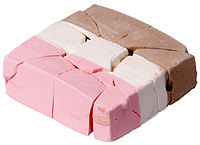
Effects of pollination on the composition of volatile compounds in Coffea arabica l.
Sign Up to like & getrecommendations! Published in 2022 at "Journal of the science of food and agriculture"
DOI: 10.1002/jsfa.11769
Abstract: BACKGROUND Pollination enhances coffee quality at the material level, improves the symbolic attributes of coffee and promotes sustainability. The objective of this work was to quantify the composition of volatile compounds in roasted coffee produced… read more here.
Keywords: coffee; volatile compounds; pollination; coffee beans ... See more keywords

GC/MS-based metabolic profiling for the evaluation of solid state fermentation to improve quality of Arabica coffee beans
Sign Up to like & getrecommendations! Published in 2020 at "Metabolomics"
DOI: 10.1007/s11306-020-01678-y
Abstract: Introduction Coffee fermentation has been reported as one key process in aroma and flavor development of coffee. However, natural fermentation often results in inconsistent quality of coffee. In this study, second fermentation using isolates from… read more here.
Keywords: second fermentation; fermentation; coffee beans; improve quality ... See more keywords

Levels of Antioxidant Activity and Fluoride Content in Coffee Infusions of Arabica, Robusta and Green Coffee Beans in According to their Brewing Methods
Sign Up to like & getrecommendations! Published in 2017 at "Biological Trace Element Research"
DOI: 10.1007/s12011-017-0963-9
Abstract: Coffee is a rich source of dietary antioxidants, and this property links with the fact that coffee is one of the world’s most popular beverages. Moreover, it is a source of macro- and microelements, including… read more here.
Keywords: antioxidant activity; fluoride content; coffee beans; green coffee ... See more keywords

Production of Biodiesel from Vietnamese Waste Coffee Beans: Biofuel Yield, Saturation and Stability are All Elevated Compared with Conventional Coffee Biodiesel
Sign Up to like & getrecommendations! Published in 2017 at "Waste and Biomass Valorization"
DOI: 10.1007/s12649-016-9715-x
Abstract: The suitability of biodiesel produced from spent Vietnamese coffee was examined. Previous work shows that the geographical origin of coffee beans has little effect on the composition and physical properties of the biodiesel produced Jenkins… read more here.
Keywords: coffee biodiesel; biodiesel; vietnamese coffee; coffee beans ... See more keywords

Efficient coffee beans mucilage layer removal using lactic acid fermentation in a stirred-tank bioreactor: Kinetic, metabolic and sensorial studies
Sign Up to like & getrecommendations! Published in 2018 at "Food Bioscience"
DOI: 10.1016/j.fbio.2018.10.005
Abstract: Abstract Post-harvest coffee processing involves a microbial process to remove the mucilage layer adhering to the fruits, prior to storage and transport of the coffee beans. In this study, coffee mucilage removal was done using… read more here.
Keywords: coffee; fermentation; coffee beans; process ... See more keywords

Potential of alternative solvents to extract biologically active compounds from green coffee beans and its residue from the oil industry
Sign Up to like & getrecommendations! Published in 2019 at "Food and Bioproducts Processing"
DOI: 10.1016/j.fbp.2019.02.005
Abstract: Abstract Food waste causes great impact on society and the environment. Residues disposal is observed throughout the production chain, which establishes a need to use both food as a whole and the possibility of maintaining… read more here.
Keywords: compounds green; coffee beans; oil industry; green coffee ... See more keywords

Effect of different drying techniques on bioactive components, fatty acid composition, and volatile profile of robusta coffee beans.
Sign Up to like & getrecommendations! Published in 2017 at "Food chemistry"
DOI: 10.1016/j.foodchem.2017.04.156
Abstract: This study investigated the effect of different drying techniques, namely, room-temperature drying (RTD), solar drying (SD), heat-pump drying (HPD), hot-air drying (HAD), and freeze drying (FD), on bioactive components, fatty acid composition, and the volatile… read more here.
Keywords: effect different; drying techniques; bioactive components; coffee beans ... See more keywords

Distinguishing the region-of-origin of roasted coffee beans with trace element ratios.
Sign Up to like & getrecommendations! Published in 2020 at "Food chemistry"
DOI: 10.1016/j.foodchem.2020.126602
Abstract: Determining coffee region-of-origin is most appropriately addressed through analyses of the product available to the consumer. We analyzed the concentrations of 44 trace elements in 53 samples of roasted Arabica coffee beans (Coffea arabica) from… read more here.
Keywords: element ratios; distinguishing region; coffee beans; region origin ... See more keywords

Near-infrared spectroscopy and multivariate calibration as an alternative to the Agtron to predict roasting degrees in coffee beans and ground coffees.
Sign Up to like & getrecommendations! Published in 2021 at "Food chemistry"
DOI: 10.1016/j.foodchem.2021.130471
Abstract: Agtron method is widely used in the industry to determine roasting degrees in whole and ground coffee but it suffers from some inconveniences associated with unavailability of equipment, high cost, and lack of reproductive results.… read more here.
Keywords: agtron; beans ground; degrees coffee; coffee beans ... See more keywords

Bioaccessibility and bioactivities of phenolic compounds from roasted coffee beans during in vitro digestion and colonic fermentation.
Sign Up to like & getrecommendations! Published in 2022 at "Food chemistry"
DOI: 10.1016/j.foodchem.2022.132794
Abstract: Bioaccessibility and bioactivity of phenolic compounds in coffee beans relate to roasting and digestion process. This study aimed to estimate phenolic content, antioxidant potential, bioaccessibility, and changes in short chain fatty acids (SCFAs) production during… read more here.
Keywords: coffee beans; digestion; colonic fermentation; bioaccessibility ... See more keywords

Storage fungi and ochratoxin A associated with arabica coffee bean in postharvest processes in Northern Thailand
Sign Up to like & getrecommendations! Published in 2021 at "Food Control"
DOI: 10.1016/j.foodcont.2021.108351
Abstract: Abstract Arabica coffee is one of the most popular varieties globally; however, during postharvest and storage, it can be contaminated by fungi which produce mycotoxins such as ochratoxin A (OTA). The goal of this study… read more here.
Keywords: arabica coffee; coffee beans; coffee; aspergillus section ... See more keywords